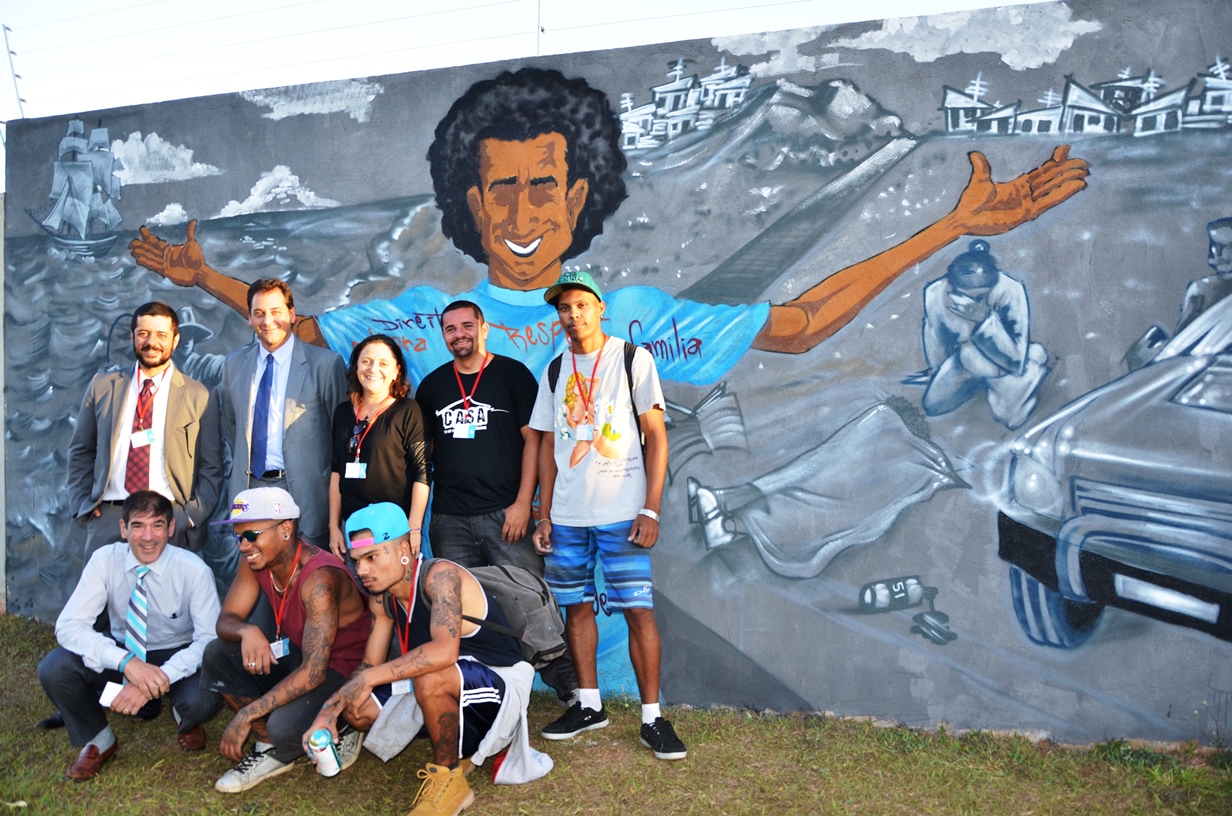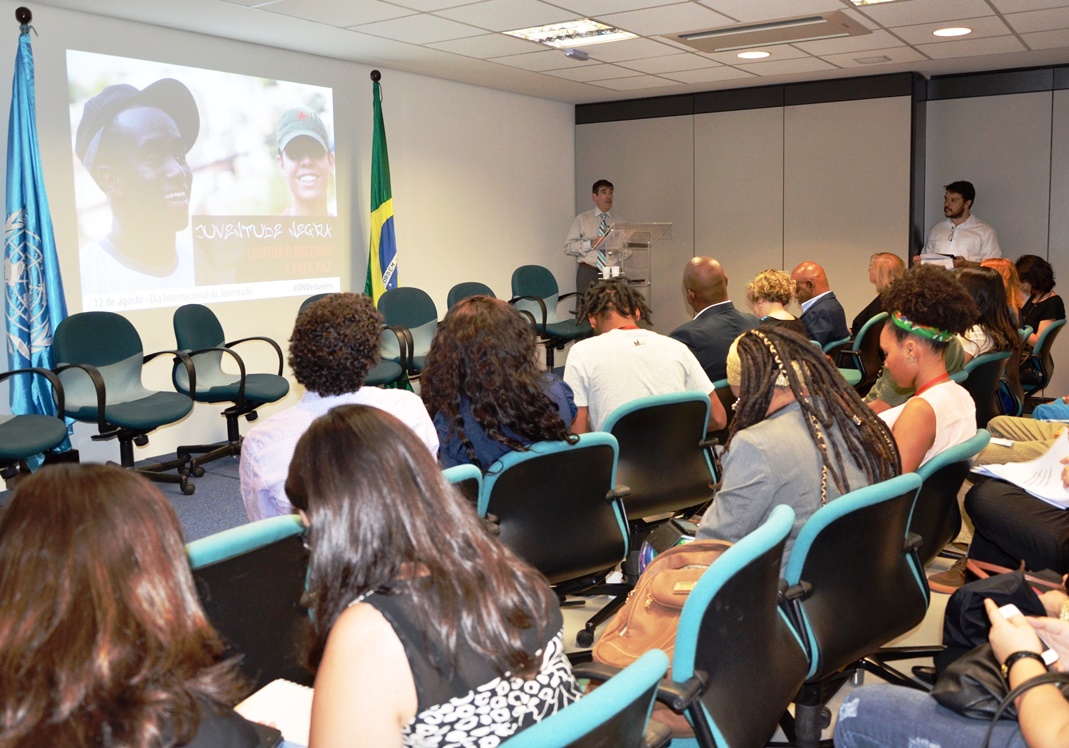Youths paint graffiti at UN House in Brazil for International Youth Day

|
|
Grafiti artists and members of UNODC and Caixa Seguros in front of the panel
|
Brasília, 15 August 2014 - The United Nations House in Brazil - the Sergio Vieira de Mello Compound - opened its doors on Tuesday to young Brazilians to celebrate International Youth Day. A graffiti on the topic Black Youth against Racism and for Peace was painted on one of the compound's internal walls by young artists from Brazil's Federal District, who have participated in the Youth of Expression Program carried out by Caixa Seguros Group, in partnership with the United Nations Office on Drugs and Crime (UNODC), UNESCO in Brazil, and the Urban Network of Social Action (R.U.A.S.). In addition, leaders of the Federal District's black youth movement and public managers participated in a debate to discuss violence, which is the main concern of young Brazilians today.
The Numbers data justifies this concern. According to estimates of the Resident Population from Datasus/Ministry of Health, Brazil had 52.2 million young people in 2012, 30,000 of whom were victims of homicide that year, which corresponds to more than half of homicides in the entire country (53.38%). Among the victims, 77.02% were black. The number of homicides of young black people is three times higher than the number of homicides of young white people.
"The theme chosen for the mobilization held today is a response to the main concern young Brazilians: violence. In Brazil, there are more than 50 million people between 15 and 29 years of age. Advances in the country's economy have provided a better quality of life for these young people, who have greater access to higher and professional education, as well as to the labor market", said the Resident Coordinator of the UN System in Brazil, Jorge Chediek, during the inauguration of the Black Youth against Racism and for Peace panel. "However, data shows that violence can constitute a significant barrier for these young people to achieve their dreams", he concluded.
Higher education has become more accessible to young people; more and more young people are getting into the formal labor market. According to the Brazil Youth Agenda, a survey conducted by the National Youth Secretariat, "this generation is more educated than the previous one; more than 50% have had access to high school, while this level of education was achieved by only 25% of their parents".
However, the higher access to education and jobs, even with all the problems still faced today, has not necessarily been efficient as a harm reduction factor. The number of deaths among young black people continues to increase.
Does the increase in access to education and work reduce young people's exposure to violence? This was one of the questions discussed during the debate. For the participants, promoting access to education and jobs is not enough, as data shows a strong presence of racism.
"Learning does not happen only in a school environment, but entering this space (university) was not easy. Staying there was also not easy, with teachers telling me that it was not a place for me", said Davidson Pereira de Souza, a journalism graduate who has participated in the Youth of Expression Program. "You need to show society that you can handle it".
The Representative of the Secretariat for Racial Equality Promotion Policies, Felipe Freitas, said that "we must get these young people away from violence. We must discuss new models of public safety".
For the participants of the debate, the media tends to reinforce stigma about black youths, maintaining the collective imagination that removes the inherent identity of black people, which reinforces the signs of exclusion and authorizes violence against black bodies. "And it is this removal of black people's identity that opens the doors to a number of exclusions", said Big Richard, a presenter, sociologist and member of the Hip Hop Nation Brazil, at the opening of the discussion.
Black Youth and the UN
One of the conclusions of the debate is that the way society treats homicides and violence against black youths - the phenomenon of naturalization of these facts - demonstrates a serious problem faced by these young people: the existence of racism in our society today.
According to data from IBGE obtained from the 2010 Census, Brazil is the country that has the largest number of afrodescendants, equivalent to 100 million people. Yet, the country is still facing racism and intolerance inherited from its colonial past. "We cannot have this discussion without addressing the issue of institutional racism," said Élida Miranda, a member of the National Youth Council (CONJUVE) and the NGO Geledés.

|
|
Representative of UNODC speaks during the debate
|
When questioned if racism creates inequality, participants stated that racism does not have inequality as its main product, but dehumanization. "In hip-hop we say that harm reduction is to not kill bros", said Larissa Borges, articulation coordinator of Brazil's National Youth Secretariat . "The Youth Statute reaffirms the right to be young, especially the right to autonomy and to experiment, in order to allow youths to build new perspectives of existence".
"In the current UN agenda, youth is a priority", said Ana Inés Mulleady, Deputy Representative of UNDP, the leading UN agency in the UN Advisory Group on Youth, composed of nine agencies of the UN System in Brazil (UNDP, UNICEF, UNESCO, UNFPA, UN Women, UNODC, ILO, UN-HABITAT and UNV), Brazil's National Youth Secretariat and civil society organizations represented by CONJUVE.
The representative of the UNODC Liaison and Partnership Office in Brazil, Rafael Franzini, also attended the event on Tuesday. "The fact that homicide is the leading cause of death of young people in Brazil demonstrates the urgency of the work of UN agencies with the Brazilian government to promote the development of public policies that protect young people and reduce their vulnerability, offering them opportunities to access education, training and information, which will provide them with the necessary conditions so that they can achieve their full potential", he said.
"Black girls are affected in a specific way by racism and sexism. These inequalities limit their opportunities to live, participate and be fully able to make decisions about their own lives", said the UN Women Representative in Brazil, Nadine Gasman. "However, they are the new generation of black women - those whose legacy is filled with stories of resistance and struggles that have changed Brazil in a positive way. These young girls are making a difference. They are organized and they are building a new reality throughout the country, through the appreciation of black women".
The UNFPA Representative in Brazil, Harold Robinson, highlighted that "young black men and women have the right to a dignified life without discrimination, free from racism and violence, with equal access to education, quality health care and decent jobs". According to him, "we need to invest in youth through policies, programs and multisectoral actions to prevent unnecessary premature deaths that can be avoided, create spaces for youth participation and ensure their full development, especially in the current context of the end of the demographic bonus".
Black Youth for Peace
The agenda against violence, racism and genocide against black youth has mobilized government, civil society and other organizations in many ways. This debate at the UN House and the inauguration of the graffiti panel is a positive and and historic fact.
Promoted by the UN Advisory Group on Youth and supported by several agencies of the UN System in Brazil, the initiative aimed to highlight the problems arising from the cycle of violence in which black youths are placed, as well as its effects on family life, school, work, health, love life and all other dimensions of the lives of these young people and their families, including their choices.
Just like the debate and the wide repercussion across the UN system social media channels, the graffiti panel inaugurated at the Sergio Vieira de Mello Complex will stay on as a landmark of the beginning of this mobilization effort towards peace and fight against discrimination and racism against black youths.
"We brought color to the image of the youngster; we wanted to highlight the main character, the young black man himself. We wanted to bring to this panel this young man becoming empowered or indicating the paths that can be taken in order to have a better quality of life", said Vinícius Rodrigues, representing the young graffiti artists. Lapixa, as he is known by his colleagues, is one of the seven young people who were selected to work as agents of the Youth Expression Program in 2013.
The activity is also a preparation for the launch of a campaign by the UN System in Brazil in November, as part of the upcoming United Nations International Decade for People of African Descent.
Decade for People of African Descent
The International Decade for People of African Descent was created by the United Nations General Assembly in 2013, under the theme "People of African descent: recognition, justice and development". The celebratory decade will begin on 1st January 2015 and will end on 31st December 2024. It builds upon the efforts of the UN Member States to tackle racism, discrimination and racial prejudice and aims to implement international commitments against racism, including the Durban Declaration and Program of Action.
Considering that, despite actions to prohibit discrimination and racial segregation, millions of human beings continue to be victims of racism, racial discrimination, xenophobia and related intolerance, including their contemporary manifestations, some of which take violent forms. According to the resolution that created the International Decade for People of African Descent, "all human beings are born free and equal in dignity and rights and have the potential to contribute constructively to the development and well-being of their societies, and that any doctrine of racial superiority is scientifically false, morally condemnable, socially unjust and dangerous and should be rejected together with theories that attempt to determine the existence of separate human races".